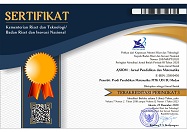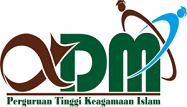Evaluating the influencing factors high order thinking skills of outstanding student by analytic hierarchy process (AHP) method
Abstract
This study aims to identify various factors that influence the development of higher-order thinking skills in the Master’s program mathematics education department at Universitas HKBP Nommensen. The systematic AHP method allows for accurate weighting and prioritization of various factors influencing HOTS. These results provide a strong foundation for policy recommendations and educational practices aimed at enhancing higher-order thinking skills among outstanding students. The ranking results of the factors influencing HOTS among 100 outstanding students in the Master's program in Mathematics Education were analyzed using the hierarchy of one factor over another. By observing the three criteria and ten sub-criteria, it can be concluded that Criterion 2, or students, is the most influential factor in determining students' HOTS with a weight of 0.53. The second influencing factor is Criterion 1, or lecturers, with a weight of 0.13, and the least influential factor is the learning environment with a weight of 0.07. Matrix interpretation shows that the Lecturer factor (K1) is considered more important than the Student factor (K2) and the Learning Environment factor (K3) in influencing the HOTS of high-achieving students. This highlights how important lecturers are in helping students develop higher-order thinking abilities.
Keywords
Full Text:
PDFReferences
Abosalem, Y. (2016). Assessment techniques and students’ higher-order thinking skills. International Journal of Secondary Education, 4(1), 1–11. https://doi.org/10.11648/j.ijsedu.20160401.11
Ananiadou, K., & Claro, M. (2009). 21st century skills and competences for new millennium learners in oecd countries. In OECD Education Working Papers (Issue 41). OECD. https://doi.org/10.1787/218525261154
Benidiktus, T. (2016). Development of an instrument to measure higher order thinking skills in senior high school mathematics instruction. Journal of Education and Practice, 7(21), 144–148. https://www.iiste.org/Journals/index.php/JEP/article/view/31982
Bhattacharya, D., & Mohalik, R. (2021). Factors influencing students’ higher order thinking skills development. Education India Journal : A Quarterly Refereed Journal of Dialogues on Education, 10(1), 349–361. https://bit.ly/4gQg96m
Chalkiadaki, A. (2018). A systematic literature review of 21st century skills and competencies in primary education. International Journal of Instruction, 11(3), 1–16. https://doi.org/10.12973/iji.2018.1131a
Collins, R. (2014). Skills for the 21st century: teaching higher-order thinking. Curriculum & Leadership Journal, 12(14), 31–39. https://shorturl.at/UjEIM
Elfeky, A. (2018). The effect of personal learning environments on participants’ higher order thinking skills and satisfaction. Innovations in Education and Teaching International, 56(4), 1–12. https://doi.org/10.1080/14703297.2018.1534601
Garcia, L.C. (2015). Environmental science issues for higher-order thinking skills (hots) development: a case study in the philippines. In Biology Education and Research in a Changing Planet. Springer. https://doi.org/10.1007/978-981-287-524-2_5
Garside, A.K., & Kristiandy, M.J. (2014). Integrasi analytic hierarchy process dan goal programming dalam pemilihan pemasok. Jurnal Teknik Industri, 14(2), 192–201. https://doi.org/10.22219/jtiumm.vol14.no2.192-201
Gong, D., Yang, H.H., & Cai, J. (2020). Exploring the key influencing factors on college students ’ computational thinking skills through flipped-classroom instruction. International Journal of Educational Technology in Higher Education, 17(19), 1–13. https://doi.org/10.1186/s41239-020-00196-0 RESEARCH
Gopalan, S.V., & Gozali, D. (2019). Review artikel: formulasi dan evaluasi sediaan granul effervescent dan sediaan tablet dengan metode granulasi basah. Farmaka, 16(1), 117–123. https://doi.org/10.24198/jf.v16i1.17353.g8615
Heong, Y.M., Sern, L.C., Kiong, T.T., & Mohammad, M.M.B. (2016). The role of higher order thinking skills in green skill development. MATEC Web of Conferences, 70(05001), 1–5. https://doi.org/10.1051/matecconf/20167005001
Hozairi, H., Qomar, A.N., Hoiriyah, & Wafi, A. (2022). Penerapan metode hybrid ahp-topsis pada sistem pendukung keputusan pemilihan program studi terbaik di universitas islam madura. Bina Insani Ict Journal, 9(2), 93–101. https://doi.org/10.51211/biict.v9i2.1833
Husamah, H., Fatmawati, D., & Setyawan, D.H. (2018). Oidde learning model: improving higher order thinking skills of biology teacher candidates. International Journal of Instruction, 11(249–264). https://doi.org/10.12973/iji.2018.11217a
Hwang, G.J., Lai, C.L., Liang, J.C., Chu, H.C., & Tsai, C.C. (2017). A long-term experiment to investigate the relationships between high school students’ perceptions of mobile learning and peer interaction and higher-order thinking tendencies. Educational Technology Research and Development, 66(6), 1–19. https://doi.org/10.1007/s11423-017-9540-3
Ichsan, I.Z., Sigit, D.V., Miarsyah, M., Ali, A., Arif, W.P., & Prayitno, T.A. (2019). Hots-aep: higher order thinking skills from elementary to master students in environmental learning. European Journal of Educational Research, 8(4), 935–942. https://doi.org/10.12973/eu-jer.8.4.935
Jerome, C., Lee, J.A.C., & Ting, S.H. (2017). What students really need: Instructional strategies that enhance higher order thinking skills (hots) among unimas undergraduates. International Journal of Business and Society, 18(S4), 661–668. https://www.ijbs.unimas.my/images/repository/pdf/Vol18-s4-paper2.pdf
Li, Y., Yang, H.H., MacLeod, J., & Dai, J. (2019). Developing the rotational synchronous teaching (rst) model: Examination of the connected classroom climate. Australasian Journal of Educational Technology, 35(1), 116–134. https://doi.org/10.14742/ajet.4010
Lu, Y., Wu, J., Peng, J., & Lu, L. (2020). The perceived impact of the covid-19 epidemic: evidence from a sample of 4807 smes in sichuan province, China. Environmental Hazards, 19(1), 1–18. https://doi.org/10.1080/17477891.2020.1763902
MacLeod, J., Yang, H.H., Zhu, S., & Melniczuk, A. (2018). Understanding students’ preferences toward the smart classroom learning environment: Development and validation of an instrument. Computers & Education, 122(3), 80–91. https://doi.org/10.1016/j.compedu.2018.03.015
Munthafa, A.E., & Mubarok, H. (2017). Penerapan metode analytical hierarchy process dalam sistem pendukung keputisan penentuan mahasiswa berprestasi. Jurnal Siliwangi, 3(2), 192–201. https://doi.org/10.37058/jssainstek.v3i2.355
Saptono, A., Suparno, & Wibowo, A. (2020). An analysis of higher-order thinking skills (hots) in the learning of economics. International Journal of Learning, Teaching and Educational Research, 19(4), 268–290. https://doi.org/10.26803/ijlter.19.4.16
Saaty, T.L. (2008). Decision making with the analytic hierarchy process. International Journal Services Sciences, 1(1), 83–98. https://doi.org/10.1108/JMTM-03-2014-0020
Tanujaya, B., Mumu, J., & Margono, G. (2017). The relationship between higher order thinking skills and academic performance of student in mathematics instruction. International Education Studies, 10(11), 78. https://doi.org/10.5539/ies.v10n11p78
Xia, B.S. (2017). An in-depth analysis of teaching themes and the quality of teaching in higher education: evidence from the programming education environments. International Journal of Teaching and Learning in Higher Education, 29(2), 245–254. https://eric.ed.gov/?id=EJ1146146
Yang, C.M. (2018). Applying design thinking as a method for teaching packaging design. Journal of Education and Learning, 7(5), 52–61. https://doi.org/10.5539/jel.v7n5p52
Yusoff, W.M.W., & Seman, S.C. (2018). Teachers ’ knowledge of higher order thinking and questioning skills : a case study at a primary school in terengganu , malaysia. International Journal of Academic Research in Progressive Education and Development, 7(2), 45–63. https://doi.org/10.6007/IJARPED/v7-i2/4120
Zaharin, N.L., Sharif, S., & Mariappan, M. (2018). Computational thinking: a strategy for developing problem solving skills and higher order thinking skills (hots). International Journal of Academic Research in Business and Social Sciences, 8(10), 1265–1278. https://doi.org/10.6007/ijarbss/v8-i10/5297
Zohar, A., & Agmon, V.A. (2018). Raising test scores vs. teaching higher order thinking (hot): senior science teachers’ views on how several concurrent policies affect classroom practices. Research in Science & Technological Education, 36(2), 243–260. https://bit.ly/3WmJZHw
DOI: http://dx.doi.org/10.30821/axiom.v13i2.22124
Refbacks
- There are currently no refbacks.
Copyright (c) 2024 Dame ifa Sihombing

This work is licensed under a Creative Commons Attribution-ShareAlike 4.0 International License.
p-ISSN: 2087-8249 | e-ISSN: 2580-0450
Indexed by:
AXIOM : Jurnal Pendidikan dan Matematika is licensed under a Creative Commons Attribution-ShareAlike 4.0 International License.











